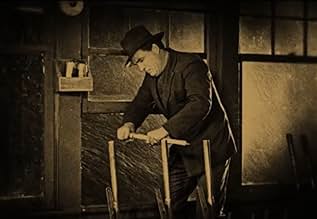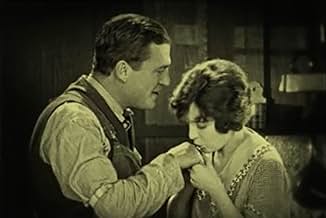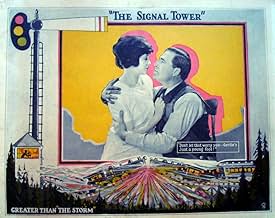IMDb-BEWERTUNG
6,6/10
122
IHRE BEWERTUNG
Füge eine Handlung in deiner Sprache hinzuA railroad worker accepts a colleague's offer to stay in his home, but when his friend is called out one night to stop a runaway train, he makes a play for the man's wife.A railroad worker accepts a colleague's offer to stay in his home, but when his friend is called out one night to stop a runaway train, he makes a play for the man's wife.A railroad worker accepts a colleague's offer to stay in his home, but when his friend is called out one night to stop a runaway train, he makes a play for the man's wife.
- Auszeichnungen
- 2 wins total
Fotos
Handlung
WUSSTEST DU SCHON:
- WissenswertesA print of this film survives in the UCLA Film and Television Archives.
Ausgewählte Rezension
I watched the restoration of "The Signal Tower" as part of the final day of the Stummfilmtage Bonn film festival, the screenings of which were graciously streamed for free--a silver lining of this pandemic and something--not the pandemic, that is--that I hope is repeated in years to come (the Pordenone festival will also be streamed again this coming October, by the way, so yay!). This particular restoration had previously appeared at the San Francisco Silent Film Festival, but unfortunately that festival has been exclusively in-person events (it's been canceled these past two years), although they do feature a few presentations and restorations from past events on their website. The 2019 4k restoration is from two 16mm prints that were sold for home use, which added up to 6,162 feet of film from the originally 6,207-feet seven-reeler, so pretty close to the original length--much better than "The Great Light" ("Gas Grosse Licht," 1920), the other film shown on the festival's last day, for which less than half the film survives, albeit in 35mm form.
As for the photoplay itself, thankfully, to liven up the Mendocino Mountains setting, Wallace Beery is in it, because it very much needed his mustache-twirling baddie (well, he doesn't actually twirl his mustache, but he might as well have, and I can imagine that those few feet of missing film are exclusively of him doing such). Before his arrival, it's just locomotive porn and domestic bliss so cutesy-wootsy I wanted to vomit. Although it was one of Universal's prestigious "Jewel" productions and was directed by Clarence Brown, who went on to be nominated for six Oscars later in his career, "The Signal Tower" has a bit of the feel of a programmer, but with a larger budget--a generic action melodrama with all the suspense held off until the end, as simultaneously loose train cars are rolling towards collision with an on-coming train and Berry's rapacious villain is attacking the heroic tower signaler's wife. It's a double last-minute-rescue scenario--a more elaborate variation on the one-reelers D. W. Griffith churned out more than a decade prior. Men racing in fast forms of transportation, frantic telegraphing or phone calling, and the threat of the dastardly villain raping the damsel-in-distress included. Somehow, this one winds up with a moral of a boy playing with a gun turning out to be a good thing, but the whole scenario is already contrived by that point. It's not bad for what it is.
In general, the focus on trains in cinema is interesting, too. Both represent modernity and technology transforming the world--making it seem smaller in many ways, as transport and movies either bring you to another part of the world more quickly or the world to you visually. The windows to shifting scenery in passenger cars and the projection of recorded images on a screen changing how we see the world. It's no wonder why trains were especially so popular in early cinema, from the Lumière's "Arrival of a Train" (1896) and the numerous phantom-ride views, to "The Great Train Robbery" (1903) and the creation of the Western genre.
One thing I thought neat about this revival of that fascination is the boy's toy train set. After we're introduced to it, the scene follows up with an illustrative story told to the boy by his father, of a train derailing or exploding. The train in the flashback story, as well as in some other train footage later, was made with miniatures--just like the boy's train set. The effects aren't all that much better than when Robert W. Paul and Walter R. Booth created "A Railway Collision" back in 1900, but the framing of such in the narrative here is nicely reflexive and in opposition to the real train footage opening the film and that which is later mixed with the miniatures throughout the rest of the picture.
As for the photoplay itself, thankfully, to liven up the Mendocino Mountains setting, Wallace Beery is in it, because it very much needed his mustache-twirling baddie (well, he doesn't actually twirl his mustache, but he might as well have, and I can imagine that those few feet of missing film are exclusively of him doing such). Before his arrival, it's just locomotive porn and domestic bliss so cutesy-wootsy I wanted to vomit. Although it was one of Universal's prestigious "Jewel" productions and was directed by Clarence Brown, who went on to be nominated for six Oscars later in his career, "The Signal Tower" has a bit of the feel of a programmer, but with a larger budget--a generic action melodrama with all the suspense held off until the end, as simultaneously loose train cars are rolling towards collision with an on-coming train and Berry's rapacious villain is attacking the heroic tower signaler's wife. It's a double last-minute-rescue scenario--a more elaborate variation on the one-reelers D. W. Griffith churned out more than a decade prior. Men racing in fast forms of transportation, frantic telegraphing or phone calling, and the threat of the dastardly villain raping the damsel-in-distress included. Somehow, this one winds up with a moral of a boy playing with a gun turning out to be a good thing, but the whole scenario is already contrived by that point. It's not bad for what it is.
In general, the focus on trains in cinema is interesting, too. Both represent modernity and technology transforming the world--making it seem smaller in many ways, as transport and movies either bring you to another part of the world more quickly or the world to you visually. The windows to shifting scenery in passenger cars and the projection of recorded images on a screen changing how we see the world. It's no wonder why trains were especially so popular in early cinema, from the Lumière's "Arrival of a Train" (1896) and the numerous phantom-ride views, to "The Great Train Robbery" (1903) and the creation of the Western genre.
One thing I thought neat about this revival of that fascination is the boy's toy train set. After we're introduced to it, the scene follows up with an illustrative story told to the boy by his father, of a train derailing or exploding. The train in the flashback story, as well as in some other train footage later, was made with miniatures--just like the boy's train set. The effects aren't all that much better than when Robert W. Paul and Walter R. Booth created "A Railway Collision" back in 1900, but the framing of such in the narrative here is nicely reflexive and in opposition to the real train footage opening the film and that which is later mixed with the miniatures throughout the rest of the picture.
- Cineanalyst
- 23. Aug. 2021
- Permalink
Top-Auswahl
Melde dich zum Bewerten an und greife auf die Watchlist für personalisierte Empfehlungen zu.
Details
- Erscheinungsdatum
- Herkunftsland
- Sprachen
- Auch bekannt als
- The Signal Tower
- Drehorte
- Produktionsfirma
- Weitere beteiligte Unternehmen bei IMDbPro anzeigen
- Laufzeit1 Stunde 12 Minuten
- Sound-Mix
- Seitenverhältnis
- 1.33 : 1
Zu dieser Seite beitragen
Bearbeitung vorschlagen oder fehlenden Inhalt hinzufügen

Oberste Lücke
By what name was Das rote Signal (1924) officially released in Canada in English?
Antwort






















